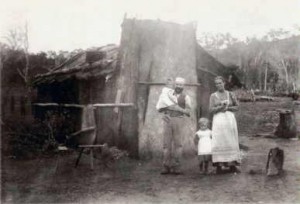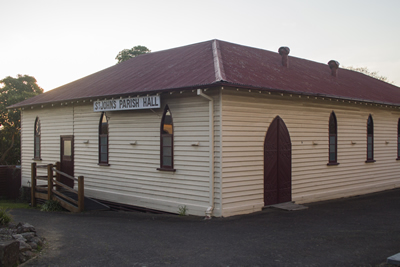History of Alexandra
 The Township of Alexandra began as a mining camp. Gold was discovered 1n 1866 and 1867 and the settlement sprang up nearby. The Town was named in honour of ”The Rose of Denmark”, Princess Alexandra Caroline Charlotte Louise Julie [1844 –1925 ], wife of Albert, Prince of Wales.
The Township of Alexandra began as a mining camp. Gold was discovered 1n 1866 and 1867 and the settlement sprang up nearby. The Town was named in honour of ”The Rose of Denmark”, Princess Alexandra Caroline Charlotte Louise Julie [1844 –1925 ], wife of Albert, Prince of Wales.
The Shire of Alexandra was formed in 1869 and existed until Council amalgamations of 1994 combined it with the Shire of Yea and parts of the Shires of Eltham and Broadford to form Murrindindi Shire.
History of St John’s
 The life of the Anglican Church at Alexandra – as described in the 1958 Appeal Brochure – began about 10 years before our earliest records – we have a continuity of records from 1867. A Lay Reader Mr Ashe, preached around the area, from a Mission in Yea.
The life of the Anglican Church at Alexandra – as described in the 1958 Appeal Brochure – began about 10 years before our earliest records – we have a continuity of records from 1867. A Lay Reader Mr Ashe, preached around the area, from a Mission in Yea.
Early in 1867 the Rev. W.H. Cooper from Woods Point and Mr Watson from Kilmore, conducted services at Alexandra in private homes and in the School. In July of that year the Rev. A Toomah was appointed as Rector. The Murrindindi Heritage Study tells us that a Church of England site was reserved on the corner of Webster and Nihil Streets, Alexandra and the first timber Church of St John`s was erected there in 1868. It took only eight weeks to build and was officially opened by the Dean of Melbourne,  the Very Reverend H.B. Macartney on 16th March 1868.
the Very Reverend H.B. Macartney on 16th March 1868.
The Alexandra Standard praised the building – “The building erected is one of the prettiest wooden buildings in the district and is a credit to all connected with it. The people have liberally responded to the numerous calls made upon them and are delighted to have a place to worship Almighty God.”
A rectory was purchased for this site in 1885, but was pulled down in the early 1900s.
Our early service registers tell us that services were held at Fawcett, Acheron, Lower Acheron, Upper Thornton Hall, the Rubicon Mills, the Taggerty Hall and in many private homes. At Kanumbra services were held from about 1880 and the Church of St Paul was completed about the end of 1888.
Also in the Parish, the Church of St Thomas at Buxton was dedicated by Dr Goe, the Bishop of Melbourne, on 3rd May1895. Christ Church Marysville was built in 1914 and enlarged in 1940. Similarly Churches were established at Eildon in 1925 (this Church was moved to the new town site in 1951) and at Thornton, in a building moved from Jamieson or Darlingford – dedicated in the name of St Alban. Buxton & Marysville became a separate parish in the 1960s and Thornton and Eildon followed Kanumbra in being sold as parishioners declined.
St John’s Church
 The Anglican Church was relocated to its present site on Downey Street in the late 1930s. Louis R Williams of 100 Queen Street, Melbourne for St John`s Church, he is described in Lloyds “History of Alexandra, as the most significant Architect for the Diocese of Wangaratta, for whom he designed 7 Churches. The new church, constructed by George A Payne & Son, Master Builder, was constructed of reinforced concrete.
The Anglican Church was relocated to its present site on Downey Street in the late 1930s. Louis R Williams of 100 Queen Street, Melbourne for St John`s Church, he is described in Lloyds “History of Alexandra, as the most significant Architect for the Diocese of Wangaratta, for whom he designed 7 Churches. The new church, constructed by George A Payne & Son, Master Builder, was constructed of reinforced concrete.
The foundation stone was laid on 13th November 1937 by the Rector Rev. Douglas Blake. It was consecrated in August 1943 by the Right Reverend T.M.Armour, Bishop of Wangaratta. The style was described as “ Arts and Crafts Continuing Gothic/Norman.”
The present Church Hall was the original timber church, constructed in 1868 at the corner of Nihil and Webster Streets, Alexandra. This building was moved to its current site in 1938, next to the new Church and has been used as the church hall since then.
The present Rectory was built in 1907. It is assumed from its age that it was on the present site and retained by the Church. It was restored and extended in 1987 at a cost of approximately $ 50,000.
The Heritage study goes at great length into the history of the present Church Organ. A summary is that it was built in-c1870, by an unknown organ maker in England. It is described as having a case of carved cresting, filigree fretwork panels and two three pipe towers. It was felt to have been in a private home in Melbourne until it was installed in St Roch`s Church in Glen Iris until 1978, when it went into private hands, being restored in 1990 by S J Laurie. It was installed in St John`s Anglican Church in 1990.
The Parish Profile 1984
This document, prepared by Norma Miller, is a very valuable historical reference, of the town and its surrounding community, and the other denominations, as well as St John`s and the other Anglican churches in the Parish.
This document gives some interesting insights into the Ministers from 1935 to 1984, listing them from the first Rev D Blake 1935 to 1939, the fifth Rev John Clayden-1961 to 1966 during his time Marysville became a separate Parish, Rev George Nunan 1973 to 1984 [ credited with a major involvement in starting Kellock Lodge – Aged Care facility.]
More recently Fr Barry Johns 1991-1996, Fr Chris St.John 1996-2000, Fr Ian Crooks 2001-2004, Fr Paul Dalzell 2005-2011, Fr Geoff Poliness 2012-2014 and Father Paul Wood appointed in 2014.
Recent History of St John’s
In the 1960s, St John’s started an Opportunity Shop, later to share management and staffing with the other churches. In 1981, The Alexandra Opp. Shop was rejuvenated to help with the funding and operating costs of Kellock Lodge and is doing that still today, also helping other charities such as the Hospital.
A very important activity in the 1980’s was the initiative to create an Aged Care Facility in Alexandra. The land was donated by the Kellock Family to the Anglican Diocese of Wangaratta. The Parish remains in close involvement to this day, three of the nine Directors are nominees of the Parish and three Anglicans have been Chairman of the Board for significant periods.
Over the past 20 years or so, St John`s has suffered from the general decline in attendance at Church, the Choir being lost in the 1990s and Ministry being reduced to three days per week in recent times.
The Present and the Future
The Parish reached a low ebb during the first decade of the current Century and Father Geoff Poliness (with a background in the Melbourne/Gippsland /Bendigo and Brisbane Dioceses) was appointed as Priest-in-Charge in February 2012.
He saw the involvement of the Church in the Community as vital to the future.
This involvement is already strong in a number of ways and is supported by Father Paul Wood, appointed in 2015.
- Co-operation between Alexandra Community Health with the Parish in establishing a Community Garden & Kitchen in the Parish grounds is already operating.
- In October this year, the Open Gardens weekend, an important part of the Alexandra calendar includes a Festival of Flowers at St Johns, already booked as a week long Festival in 2013, with involvement of outside involved community members.
- The Parish Hall provides a hiring facility for community use, with few large Halls available.
- The Churches already co-operate in running the Alexandra Opportunity Shop, supporting Kellock Lodge and other community organisations.
- In 2014, the Parish, in co-operation with Anglicare started an open centre with retail operations, known as the Redgate Bazaar in Grant Street.
- The future already involves co-operation with neighbouring Anglican Parishes of Yea & Marysville with Father Paul Wood as the Team Rector.
